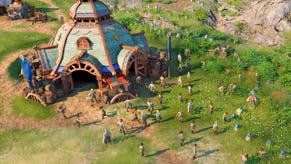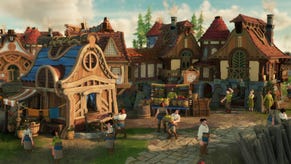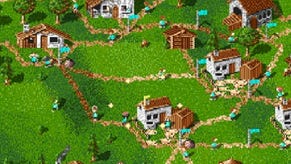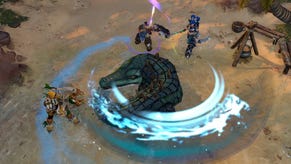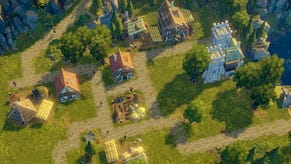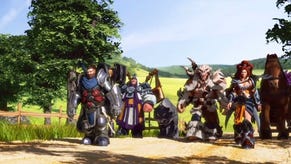The Settlers: New Allies offers a fresh yet familiar take on the 30 year old series
A 12 month delay has seen improvements across the board, and launch is just the beginning
The road to launch has been a uniquely turbulent one for The Settlers: New Allies. After an eight-year absence, the next entry in Ubisoft’s beloved city-building series was finally revealed in 2018, only to be delayed indefinitely two years later. The game then reemerged in a fresh new form in 2022, but a less than favourable reception from long-term fans to its closed beta saw the game delayed indefinitely once again.
12 months later, The Settlers: New Allies is all the better for it. An extended delay is never an easy decision to make, yet the team at Ubisoft Düsseldorf (formerly Blue Byte) has seen this additional development time as an opportunity to reach out to those most familiar with the series. “We learned [more] than just what was needed for the game,” creative director Christian Hagerdorn tells me during a recent preview event. “One of our biggest focuses was to be absolutely transparent with the players. Not just on where we were standing, but where we were going. We've been collecting the feedback as we were developing”.
It shows. The Settlers New Allies is in a more polished and focused state compared to the beta I played last year. Particular attention has been paid to the game’s economy. The research tree has been overhauled from the ground up. Returning buildings, such as the forester, add much-needed depth to settlement management. And the addition of bandits, placed strategically across multiplayer maps, prevents players from using rush tactics to end PvP games in mere minutes, an issue that plagued last year’s beta.
The result is a faster more streamlined version of The Settlers, one that is both grounded in the past and looking forward towards its future. This is shaping up to be largely the same settlement management game you remember, but modernised and refreshed.

This was most evident in the game’s campaign. I played through the opening two missions as well as a late-game scenario and (wonky voice acting aside) it’s shaping up very well indeed. Early levels revolve around constructing a functioning settlement, tasking you with setting up efficient production lines. Woodcutters chop down trees, sawmills turn them into planks, stonemasons provide bricks and a toolmaker combines them all into - surprise surprise -tools, an important resource required to build more complex structures. Set on a lush tropical island surrounded by sapphire blue oceans, these early missions offer a relaxing introduction to the game’s all-important economy. There’s plenty of time to plan your next move, and I spent the majority of my session zooming in to observe my titular Settlers going about their days. Every resource is individually rendered, allowing you to follow a tree trunk from the moment it’s chopped down to when it’s transformed into an all-important tool. Everything is meticulously animated and satisfying to observe, your tiny folks cultivating the land, hauling coal out of its depths and embarking into the great unknown to discover unique points of interest.
If mission 2 was a pool holiday in Barbados, mission 9 was being mugged behind a chippy in Birmingham. Plonked towards the end of the campaign, I was immediately attacked from two sides of my extremely exposed starting location. Panicked, I was thwomped before I even had a chance to respond, and was forced to restart. Thankfully, the second time around I was more prepared. I got to work establishing defences the second the mission loaded, a combination of decoy soldiers and arrow-shooting towers helping me survive the initial onslaught by the skin of my teeth. With the threat of attack hanging over my head, I rushed to establish optimised production pipelines to recruit more soldiers. It was a thrilling challenge of efficiency, forcing me to engage with familiar systems in a more interesting way. Those bandits were quick, frequently burning down my mines and farms before I could transform iron into weapons, but I was determined to persevere. Sadly my time ran out before I could take the battle to the bandits directly, but I was hooked. This campaign doesn’t mess around, and I’m excited to see it through to the end.

Across the three available missions I controlled two of the game’s factions: the Elari and the Jorn. Both were visually distinct (the Jorn are a Viking analogue, whereas the Elari’s buildings and clothing resemble those of western Europe) and also boasted unique abilities and traits that further set them apart. “The Jorn are more adept at certain machinery that leads them to battle faster,” Hagerdorn explains. “The Elari are much better at building houses and bakeries so that they can produce a faster population and higher population limits. And the Maru are very adept at their defences.”
I’m also taken by how New Allies’ approaches the idea of a foreign culture settling on lands that aren’t natively their own. The shadow of colonialism hangs heavy over the game’s opening moments (you begin, after all, as a western European-inspired faction rushing to find resources that will help you increase your military might) but New Allies is not about attacking those who already live here. Instead, the campaign focuses on cooperation, working together to bring down an opposing force that threatens everyone. “We came to the conclusion that we did not want to be taken as the faction who brings the war to new lands,” Hagerdorn tells me. “It's about hope. It's about finding the common ground. It's about working together despite differences and not fighting because of them.”
Before we wrapped up, Hagerdorn introduced me to the game’s recently revealed Hardcore mode. Here, players are given three challenges of increasing difficulty that each use one of the game’s skirmish maps as a foundation. Each mission has a different goal and a set of modifiers that shake things up significantly. Defeat the enemy in 45 minutes. Produce a large amount of a specific item. Maybe the map doesn’t have any coal, forcing you to acquire resources via trading instead. It’s a brilliant exploration into the finer nuances of New Allies’ mechanics, and I had enormous fun scrambling to conquer my opponent within a tight time limit. Even playing the easiest scenario, hardcore mode tested me significantly more than even the later levels of the campaign. Missions aren’t randomised but crafted by hand, and more are set to arrive after the game’s launch.
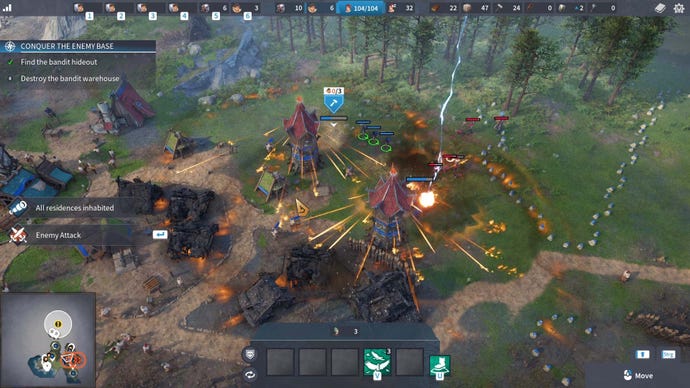
“It was very important for us to offer an experience that [allows] players to find their own difficulty within the game,” says Hagerdorn. “Hardcore mode was born out of the idea of ‘What if we offer them a handmade experience that increases the challenge drastically, but it is made for fun?’. It was just so cool to see what opportunities lie behind changing one of the rules or adding one little bit of extra pressure.” Whereas other games in the genre equate an increase in difficulty with making enemy AI faster and stronger, hardcore mode pushes a player’s knowledge of the game instead. Thankfully missions can be played as many times as you like, and support both save states and the ability to tackle them with friends. “Most of [hardcore mode] is about challenging your own decisions," explains Hagerdorn. "It's finding out how could I have done this better? It's not about how I got beat, it's how could I have prevented this from happening? How could I do better next time? And then something clicks within you and you have the solution and you go again, or you load your save game, and you go ‘I got it this time. I'm going to do this, this this.’ It all works out and you feel much better about yourself.”
One detail of hardcore mode raises a small concern. Your missions refresh every seven days, but can be re-rolled early by spending shards, a currency rewarded for completing various activities within the game. Shards are one of two in-game currencies, with Hagerdorn assuring me that both are used only for cosmetic items such as titles, avatars and skins that can be applied to buildings and units. Relatively inconsequential, then, but the worry is how this side of the game will land with fans who have already made up their mind about how New Allies stacks up against their favourites from the past.
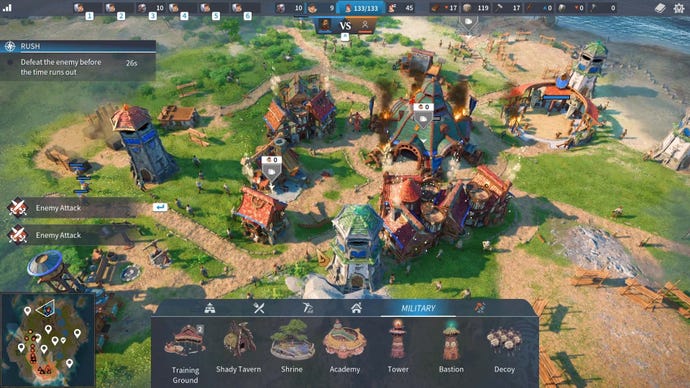
For what it’s worth, as a long-time fan myself, I really enjoyed what I played of New Allies. In its pre-release form, this is a slick and modern take on the classic Settlers formula, and hardcore mode is an exciting addition I can see myself losing a lot of time within. It seems, at this stage at least, to strike a pleasant balance between relaxing city-builder and fast-paced RTS. It’s a unique take, and one I’m keen to explore further once the game launches in a few weeks.
There’s a feeling of kismet around the multiple delays that have afflicted New Allies. Now set to launch in 2023, this year marks the 30th anniversary of The Settlers original debut. It’s an important year for the series, and as a long-time fan of all things Settlers, it’s a point of pride for Hagerdorn to find himself working on the game’s latest entry at this milestone in its long history. “There is something quite unique about the settlers that really left a mark throughout strategy games,” he tells me. “It has always been a topic that people came back to wanting to see more of, and we're happy to be here in order to offer that once again. Capturing that spirit and bringing it to modern times is a great satisfaction”.
A group of Ubisoft employees under the name ABetterUbisoft are still campaigning for the company to do more in the wake of summer 2020's allegations and revelations of widespread harassment and discrimination. Over 1000 current and former Ubisoft employees signed an open letter demanding reform. Over 200 days later, the group still say "None of our demands have been met and management refuse to engage."




